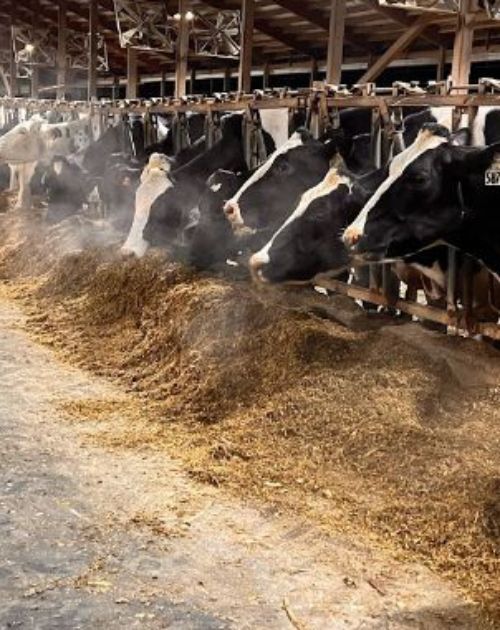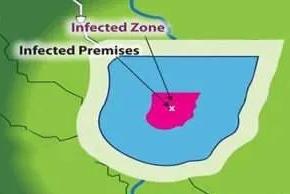Farm biosecurity and disease outbreak response plans
Prioritize safety for workers and animals.

On March 29, 2024, Highly Pathogenic Avian Influenza (HPAI) was first confirmed on a Michigan dairy farm. Since then, HPAI has been confirmed in 28 other dairy herds across the state. Policies, laws and testing requirements have changed over the past year but a few things remain the same:
- A farm biosecurity plan cannot guarantee prevention but it is a critical piece of risk reduction
- Disease outbreak response plans help farmers proactively approach new or worsening outbreaks
- MSU Extension has many resources to assist dairy producers
HPAI is a viral infection affecting poultry and dairy herds. Affected cattle display several clinical signs including reduced feed intake and rumen motility, decreased milk production, thicker concentrated colostrum-like milk that can be discolored, abnormal or loose manure and fever. Although few cattle die from HPAI infections, the impact of an outbreak on a dairy farm is challenging. An analysis of an HPAI outbreak on a Michigan farm led by Zelmar Rodriguez and colleagues estimated the net cost of the outbreak was $504 per affected cow or $158 per cow in the herd.
The continued importance of a biosecurity plan
Unfortunately, normal dairy practices and operations may have contributed to the spread of HPAI between cows and between herds in the past. While the exact methods of HPAI transmission are unknown, practices such as traveling between different work locations on larger farms, handling poultry before or after working with cattle and failing to sanitize vehicles or equipment may transmit the disease. Minimizing these practices may be an effective way to reduce HPAI transmission.
Many biosecurity practices have a direct impact on animal and human health so consistent implementation and execution is key. Ensure that farm staff and visitors understand these practices on your farm and have the tools and support to carry them out. This commonly includes:
- Separating sick animals from others and caring for healthy animals first to prevent further infection
- Preventing contact between cattle and wild and domestic birds. This can include reducing standing water and using visual deterrents for wild birds or adequate fencing to separate cattle and domestic poultry
- Cleaning and disinfecting equipment and supplies appropriately, especially when traveling between different areas on a farm or handling a sick animal
- Wearing personal protective equipment (PPE) appropriate to the task, ensuring PPE is well maintained and replacing damaged PPE
- Creating a plan for who to contact in different scenarios such as when to contact a veterinarian about an animal health issue
- Establishing a line of separation or outer boundary with designated access points. Additional features such as a parking area and cleaning stations help prevent unauthorized or contaminated vehicles from entering the farm
A key component of an effective biosecurity plan is employee education and training. In many dairy farms, combining bilingual written guidance with visual reminders is an effective way to ensure consistency and compliance.

Disease outbreak response plans
- Infectious diseases can spread through a herd quickly. An effective disease response plan includes the following:
Isolate animals showing clinical signs - Implement movement restrictions on all animals at the farm
- Contact your veterinarian
- Inventory animals on your farm, identifying potentially exposed animals and isolating them
- Monitor animal health based on veterinary advice, including taking temperatures and observing symptoms
- Communicate with employees, visitors, vendors and service providers about biosecurity practices on the farm
Other considerations for a disease outbreak include plans for safe carcass disposal, obtaining feed and other necessary supplies and managing movement restrictions during disease spread. Maintaining an emergency contact list of local, state and federal resources and keeping animal health records up to date can also help a farm respond quickly.
Help is available from many sources
Many resources exist to help dairy farmers create or update their farm biosecurity plans. These include the Animal and Plant Health Inspection Service (APHIS), Secure Milk Supply, Beef Quality Assurance, the Michigan Department of Agriculture and Rural Development (MDARD) and MSU Extension Educators.
Programs offered by MSU Extension are available in English or Spanish, can be conducted on your farm and are easy to schedule. Simply contact the educator assigned to your county. The MSU Extension Dairy website contains news articles, contact information for dairy experts and event listings. Dealing with uncertainty or facing herd health issues can be stressful as well. MSU Extension offers resources to manage farm stress, including a free teletherapy program, stress reduction resources and financial management tools.
Stay up to date on testing
As of May 2025, APHIS provides free livestock testing through two national laboratory networks. Samples are collected as part of the National Milk Testing Strategy and before interstate movement when certain conditions are met, as well as from the voluntary dairy herd status program.
In Michigan, MDARD continues to sample milk in collaboration with milk cooperatives. Samples are sent monthly from a farm or cooperative’s laboratory to the Michigan State University Veterinary Diagnostic Lab (VDL) for screening. Samples that test positive for HPAI are sent to a federal lab for confirmation. Individual results are confidential and not shared with the public.



 Print
Print Email
Email





